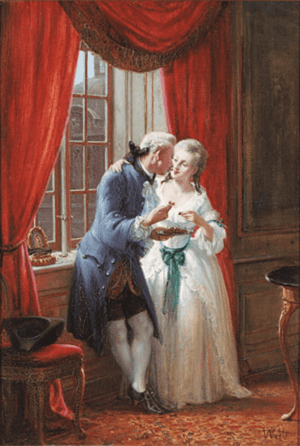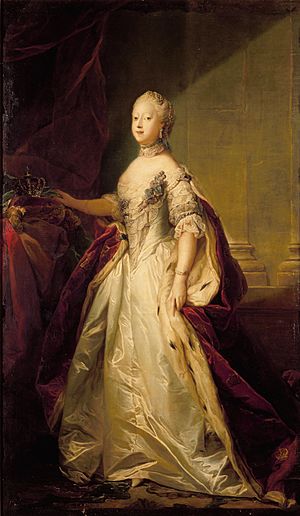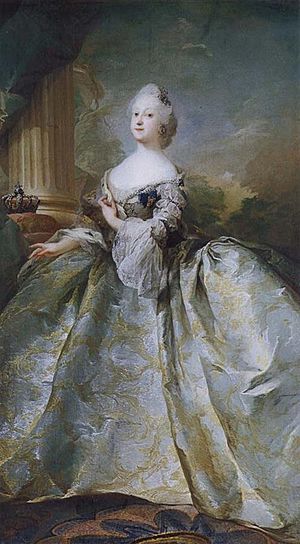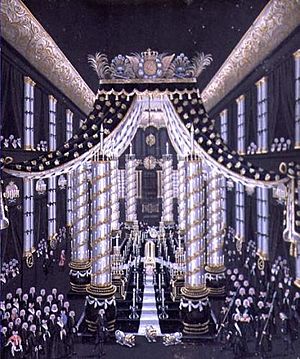Louise of Great Britain facts for kids
Quick facts for kids Louise of Great Britain |
|
|---|---|

Portrait by Carl Gustav Pilo, 1747
|
|
| Queen consort of Denmark and Norway | |
| Tenure | 6 August 1746 – 19 December 1751 |
| Coronation | 4 September 1747 |
| Born | 18 December 1724 (New Style) Leicester House, London, England |
| Died | 19 December 1751 (aged 27) Christiansborg Palace, Copenhagen, Denmark |
| Burial | Roskilde Cathedral |
| Spouse | |
| Issue |
|
| House | Hanover |
| Father | George II of Great Britain |
| Mother | Caroline of Ansbach |
Louise of Great Britain (born Louisa) was a princess from Great Britain who became the Queen consort of Denmark and Norway. She was the first wife of King Frederick V. Louise was the youngest daughter of King George II of Great Britain and Caroline of Ansbach.
Her marriage to Frederick V was arranged for political reasons. Even though it was an arranged marriage, the couple got along well, especially in the early years. Louise was very popular at the Danish court. She loved and supported performances by actors and musicians.
Contents
Growing Up as a Princess
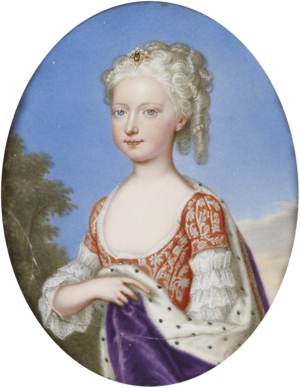
Princess Louise was born on 18 December 1724, in London. She was the fifth daughter and youngest child of the Prince and Princess of Wales. Her grandfather, George I, had become King of Great Britain in 1714. Her father, George II, became the Prince of Wales and moved to London.
Louise's father had a difficult relationship with his own father, King George I. Because of a disagreement, the King had sent his son away from court. So, Louise's family lived at Leicester House. This large house in Westminster became a meeting place for people who disagreed with King George I. Louise was born here.
She was baptized "Louisa" on 22 December. Her godparents included her older sister, Princess Amelia, and two cousins.
Princess Louise's mother had 11 children, but four of them did not survive. Louise grew up with six older brothers and sisters. She lived with her two youngest siblings, Prince William and Princess Mary, and her parents. These younger children were born in London. Her favorite sister was Princess Mary. Mary later married Frederick II, Landgrave of Hesse-Kassel. The marriages of Louise and Mary helped create many family ties between the Danish and Hesse-Kassel royal families.
When Louise was two years old, her grandfather, King George I, died. Her father then became King George II. The family moved to St James's Palace in London. Louise spent her holidays at Richmond Lodge, her parents' summer home. In 1737, when Louise was almost 13, her mother, Queen Caroline, died. After this, Louise was mainly raised by her older sister, Princess Caroline.
Her Royal Marriage
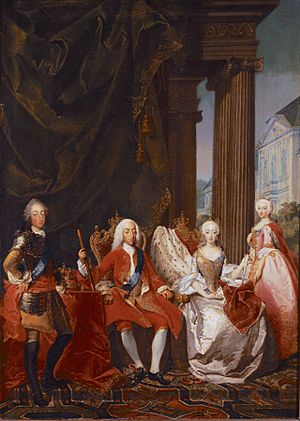
In 1743, a royal marriage was planned for Louise and Crown Prince Frederick of Denmark and Norway. Great Britain suggested this marriage for political reasons. Both France and Great Britain wanted to be allies with Denmark-Norway. Great Britain, being a Protestant country, had an advantage in forming a marriage alliance.
The Danish government liked the idea. Frederick's father, King Christian VI, was not sure at first. But he was convinced because he hoped the marriage would help Denmark get British support. This support was for his son's claim to the throne of Sweden. People also hoped the marriage would help the Crown Prince improve his behavior. Frederick agreed to marry Louise after seeing her portrait and hearing she was friendly. He also understood the political benefits of the marriage.
The marriage talks began in 1743 and finished quickly on 14 September. On 19 October, 18-year-old Princess Louise left London for Copenhagen. She sailed on the royal yacht Fubbs to Hanover, her father's German land. There, on 10 November, a proxy wedding took place. Her brother, the Duke of Cumberland, stood in for the groom.
After this, Louise and Frederick met for the first time in Altona. This was a border city in the Danish Duchy of Holstein. Louise's English helpers were replaced by Danish ones. Louise and Frederick then traveled to Copenhagen. They entered the city on 11 December to great cheers from the people. On the same day, a second wedding ceremony was held at Christiansborg Palace, the main royal residence in Copenhagen.
Life as Crown Princess
After their wedding, Louise and Frederick lived at Charlottenborg Palace. This was a smaller royal home in Copenhagen. Their home quickly became a lively and fun place. It was very different from the strict court of Louise's in-laws at Christiansborg Palace. In 1745, they moved to the Prince's Mansion. This city mansion was redesigned for them in the Rococo style.
Even though their marriage was arranged, Louise and Frederick got along well. Their relationship was friendly, especially in the first few years. They had five children together. Their eldest son, Crown Prince Christian, sadly died as a baby. Frederick respected Louise and was always kind to her.
Louise quickly became popular at the Danish court. Her father-in-law said she seemed kind and pleasant. The people of Copenhagen also liked her very much because of her natural and friendly way. Unlike her mother-in-law, Queen Sophie Magdalene, Louise tried hard to learn Danish. She studied the language as soon as she arrived. She also hired teachers so her children could learn Danish.
Becoming Queen
When King Christian VI died on 6 August 1746, Louise's husband became King Frederick V. Louise became Queen of Denmark and Norway at age 21. The new King and Queen moved into the large Christiansborg Palace. The official ceremonies for their new roles ended when they were crowned at Frederiksborg Palace on 4 September the next year.
Life at the Danish court changed a lot when Frederick V became king. It became much more festive and relaxed. The heavy iron chains that used to surround Christiansborg Palace, keeping people away, were removed. Court life became grand again. The palace's rooms were filled with balls and social events. Queen Louise was very popular in Denmark. Many people believed her popularity made the royal couple so well-liked. Louise had a lively personality and could easily talk to others. She was described as well-educated and good at conversation. She was not considered beautiful but was very dignified and perfect for her role as queen.
Her effort to speak Danish, even with her children, was much appreciated. This was because the royal Danish court mostly spoke German.
Louise loved music, dance, and theatre. In 1747, she invited an Italian opera company to Copenhagen. They performed opera and ballet at Charlottenborg Palace until 1750. The famous composer Christoph Willibald Gluck was part of this company. He stayed with the Danish court from 1748 to 1749. When Queen Louise gave birth to her son, Crown Prince Christian, Gluck wrote an opera called La Contesa dei Numi. This opera was about the Olympian Gods gathering to decide who would protect the new prince. It was performed on 12 March 1749. In 1748, a French theatre group was also invited to Copenhagen. They performed plays until 1753.
In 1751, Queen Louise did not want her five-year-old daughter, Princess Sophie Magdalene, to marry the Swedish Crown Prince, Gustav. Louise was worried that her daughter would not be treated well by the Queen of Sweden, Louisa Ulrika. Queen Louisa Ulrika was known for not liking Denmark and for being against the marriage. It was also known that she was the real power at the Swedish court. Louise reportedly disliked arranged marriages because of her own experience.
Her Early Passing
In 1751, Louise became very ill while pregnant with her sixth child. The court surgeon tried to save her, but he could not save her or her unborn baby. She passed away at Christiansborg Palace on 19 December 1751. This was the day after her 27th birthday. She had been married for 14 years and queen for only 5 years.
People at court and the public were very sad about the popular queen's death. She was greatly loved during her short time as queen. After a grand ceremony at the chapel in Copenhagen, she was buried in Roskilde Cathedral. This cathedral on the island of Zealand is the traditional burial place for Danish monarchs.
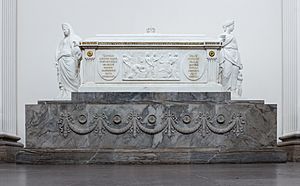
Frederick V lived for 14 years after Queen Louise died. At first, he did not want to marry another foreign princess. However, a new marriage was arranged for the king. On 8 July 1752, he married Duchess Juliana Maria of Brunswick-Wolfenbüttel. She was the sister-in-law of Frederick the Great of Prussia. People did not like this marriage because they thought it was too soon for the King to remarry. The new queen was also not popular at court. This was perhaps because her strict manners seemed less friendly than Louise's.
In 1756, Louise's sister, Mary, moved to Denmark. She came to help take care of Louise's children. Mary brought her three sons with her. The two older sons, Prince William and Prince Charles, later married their Danish cousins, Princess Wilhelmina and Princess Louise. The two younger sons, Charles and Frederick, stayed in Denmark and had careers there.
Her Lasting Impact
Because Queen Louise was so popular and loved by the Danish people, her memory became even more special over time. For example, the German poet Friedrich Gottlieb Klopstock greatly admired Queen Louise. He was very sad about her early death. He wrote a poem called An den König (later Die Königin Luise) in 1752, expressing his and the people's feelings. Compared to this ideal queen, the queens who came after her, Juliana Maria and Caroline Matilda, were judged much more harshly.
Places Named After Her
- Louisa County in Virginia was named after Princess Louise in 1742.
Issue
| Name | Birth | Death | Notes |
|---|---|---|---|
| Christian, Crown Prince of Denmark | Copenhagen, 7 July 1745 | Frederiksborg, 3 June 1747 | Died in infancy |
| Princess Sophia Magdalena of Denmark | 3 July 1746 | 21 August 1813 | Married, 1766, Gustav III of Sweden; had issue |
| Princess Wilhelmina Caroline of Denmark | 10 July 1747 | 19 January 1820 | Married, 1763, William I, Elector of Hesse; had issue |
| Christian VII of Denmark | 29 January 1749 | 13 March 1808 | Married, 1766, Princess Caroline Matilda of Wales; had issue |
| Princess Louise of Denmark | 30 January 1750 | 12 January 1831 | Married, 1766, Prince Charles of Hesse-Kassel; had issue |
See also
 In Spanish: Luisa de Gran Bretaña para niños
In Spanish: Luisa de Gran Bretaña para niños



